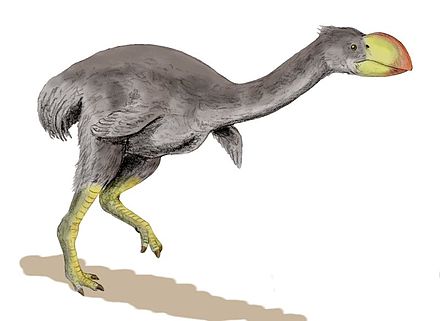Dromornithidae
Dromornithidae, known as mihirungs and informally as thunder birds or demon ducks, were a clade of large, flightless Australian birds of the Oligocene through Pleistocene Epochs. All are now extinct. They were long classified in Struthioniformes, but are now usually classified as galloanseres.[1][2][3]
Dromornithids were part of the Australian megafauna. One species, Dromornis stirtoni, was 3 m (9 ft 10 in) tall. The collective term Australian megafauna is used to describe a number of comparatively large species of animals that lived in Australia until 50,000 to 20,000 years ago. The causes for the disappearance of these animals are under dispute, though hunting by humans has been identified as a potential instigator.[4][5]
It is also not clear to what degree dromornithids were carnivores. The massive, crushing beaks of some species suggest that at least some members of the family were either a combination of carnivorous predators and scavengers or omnivores. Other features, such as the "hoof-like" feet, stomach structure, and eye structure that resulted in a wide field of vision, but likely also created a centre blind spot of about 40 degrees (which would hinder hunting significantly), suggest a more herbivorous, migratory lifestyle. The current consensus is that they were, indeed, herbivores.[6]
The scientific name Dromornithidae derives from the Greek words δρομαίος, dromaios ("swift-running") and ὀρνις, ornis ("bird"). Additionally, the family has been called thunder birds, giant emus, giant runners, demon ducks and mihirungs.[7]
The family was named by Max Fürbringer in 1888, citing W. B. Clarke and Gerard Krefft, Owen's separation from "Dromaeus" and Dinornis, and a note by von Haast allying Dromornis with Dromaeus.[8][9]What the nearest relatives of this group are is a controversial issue. For many years it was thought that dromornithids were related to ratites, such as emus, cassowaries, rheas and ostriches. It is now believed that the similarities between these groups are the result of similar responses to the loss of flight. The latest idea on dromornithid relationships, based on details of the skull, is that they evolved early in the lineage that includes waterfowl (Anseriformes). However, some phylogenetic studies have recovered them as closer to gamefowl (Galliformes).[2]
Below is the general consensus of the phylogeny under the hypothesis that they are members of Anserimorphae.[10][11][12][13][14]

